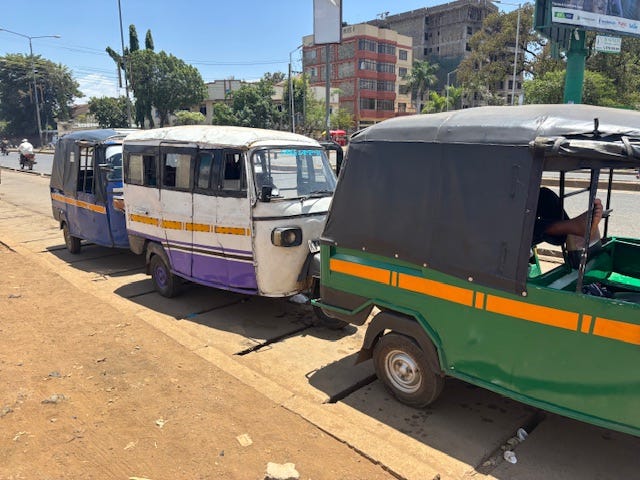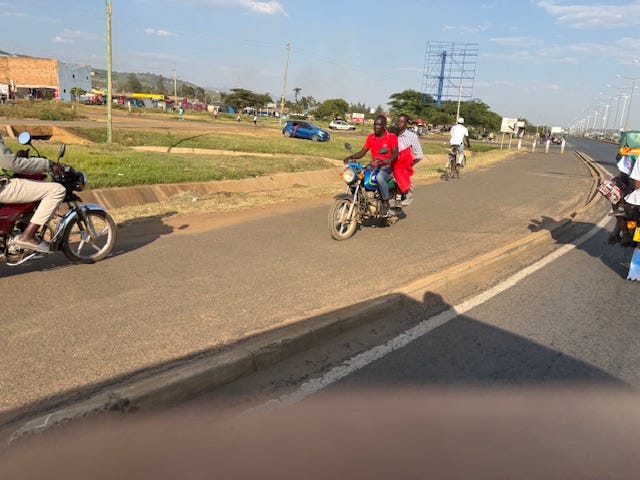Habari zenu!
So, you arrive in Kenya. But that is just the beginning of the journey. How do you make your way around Kenya? What transportation options are there?
First, I will describe the roads. Major highways and city streets in Kenya are paved with asphalt. China has actually played a big role in the development of these roads, so many people may assume foreigners of Asian descent to be Chinese because of their presence in the country working on these projects.
Almost everywhere I have seen, the paved roads, called the "tarmac," are just purposed for one lane of traffic in each direction and there are very rarely pavement markings. Only when you get nearer major cities will you begin to see pavement markings and multi-lane roads. I actually haven't seen a traffic light since I have come to Kenya. The major intersections that I have seen in the city of Kisumu utilize roundabouts/traffic circles. Then, away from the city and major highways, there are dirt roads that see decent traffic volume and others that see much less. Interestingly, both some of the paved roads and the dirt roads have occasional speed bumps to mitigate speeding.

And, no, although it is in my background, I do not have any plans to contribute to road construction here…
There are three primary modes of vehicular transportation in Western Kenya that I will talk about: matatu, tuk-tuk, and pikipiki.
Matatus
If you ain’t riding a matatu, you ain’t getting the (often sweaty and crowded) Kenyan experience. A matatu is a public van that almost always runs on the tarmac. It can be a relatively cheap option to get from village to village or town to town if you can find a route that makes sense.
Larger towns will have “matatu stages” where matatus will sit and wait until they are full or almost full. It can be a bit overwhelming at bigger stages with people trying to convince you to get into their matatu, on occasion grabbing your arm. It is important to try to find one that is almost full so that you do not have to wait a long time before departing.
Away from larger towns, though, you can wait on the side of the road or at your local village stage and wave at an approaching matatu to get it to pull over for you. They will only ignore you if there is no space for additional passengers. I am very fortunate in that a matatu will typically pass by my village every few minutes because my village is right along a major highway. When they stop for you, you state your desired destination and they will confirm they are going there. Especially as a foreigner, it is a good idea to agree on a price before boarding so that it does not become an argument once you are already on. Typically you will be asked to pay about halfway through your trip.
Many matatus will have a “conductor” that supports the driver. The conductor will collect fares, typically cash only, and manage the passenger destinations. He (I have not seen any female drivers or conductors) will sit nearest the sliding door and if the matatu is overcrowded, a conductor may even stand up and hang out the door… maybe a little dangerous. To indicate that you have reached your destination and you want to get off, or “alight” as they say here, you flick the ceiling of the vehicle twice and the driver will know to stop.
The seating in a matatu consists of five rows, seating 15-17 passengers. The back row can (tightly) fit four. Then, the fourth and third row each have three seats. They have a seat on the left side of the aisle and two seats on the right side of the aisle. To increase capacity, sometimes a wooden plank will be set on top of the seats to span the aisle and then someone will sit on the plank, called a “sambaza,” to allow four people to fit in those rows. Then, the second row is aligned with the sliding door, so it does not have a seat on the left side, just the three seats. Lastly, in the front is the driver (on the right side) and then there is room for two passengers to the left of him.
Sometimes the capacity of a matatu is really pushed because more passengers = more money, so those rides can be a bit uncomfortable. I would say the best seats are either in the front row with the driver or one of the seats along the wall next to the window because you get the breeze on what is usually a very sweaty ride, and you do not have to get out when the person next to you wants to alight. There’s also a small trunk space for luggage behind the back row of a matatu. If you have a smaller bag, though, you will just keep it on your lap or at your feet.
There are some matatus that run independently, but I often seek out those that are part of a larger matatu line because they typically have consistent fares and are reputable. However, some of the independent ones can be decked out with speakers and a television behind the driver that plays music videos, which keeps things lively. And if there is no music, there are many aggressive matatu drivers that will make questionable maneuvers, sometimes passing a vehicle when another one is oncoming... so that can also help keep you awake on your ride.
Tuk-tuk
Much more common in cities and rarely found in villages and towns are tuk-tuks. Tuk-tuks are essentially small, three-wheel taxis. The driver sits in the front and one or maybe two other people can fit there with the driver. Then, the back row can usually fit three to four people across. There is also a trunk space for bags (or, unadvisedly, a few additional passengers). Tuk-tuks can drive on paved or dirt roads, although it can be quite bumpy on the less-maintained dirt roads. Like a matatu, to get a tuk-tuk ride you flag down the vehicle and tell the driver where you want to go, but you will normally not pay until the end of the ride. Because it is more private, a tuk-tuk ride is more expensive than a matatu ride.
Pikipiki
A pikipiki is a motorbike that, like a tuk-tuk, serves as a personal taxi. Piki drivers will often be found at stages in cities with matatus, or they will wait at their own stages in smaller towns or villages. In my village and in many rural areas, pikis are very popular. They can ride on both paved and dirt roads and can take you directly to your home even if the terrain is rough. Many people may have a trusted piki driver they use consistently whom they will call upon when in need of a ride. Some teachers at my school will commute by piki every day because their distance from school requires it. Some students even resort to using them if they live far from school. Pikis can fit multiple people on the back of the motorbike, sometimes more than is safe. There are even some cases in which you will see a combination of people and animals packed onto a small piki (think two people, two goats, three chickens).
Peace Corps Kenya volunteers are actually not allowed to ride on pikipikis because they are quite dangerous. It is not uncommon to hear about an accident (sometimes even fatal—not many piki drivers wear helmets) involving a piki in the community. The consequence of getting caught riding a piki as a volunteer is having your service terminated early and being sent back to the US… so, in my opinion, not worth the risk. This restriction can be a challenge for some other volunteers who are further away from main roads due to the limited transportation options because pikis are how everyone else in their community gets around.
Other
Many volunteers have gotten bicycles to make it more accessible to reach their market, place of work, or other destination. My primary mode of transportation is "kwa miguu" or traveling “by foot".” Also of note is our school's bus that we use for transporting larger groups. People who are more well-off may have a personal car, but in the village they are not too common. For more distant travel in-country there are also buses, trains, and airports that are centered around the biggest Kenyan cities. These I have not experienced other than my flight when I arrived in the country.
Out-of-context highlight of the week: I met a Kenyan waiter at a restaurant whose name is Karl Marx.
-Daniel
Peace Corps has three objectives: (1) To help the countries interested in meeting their need for trained people, (2) To help promote a better understanding of Americans on the part of the peoples served, and (3) To help promote a better understanding of other peoples on the part of Americans. This newsletter/blog is one way in which I am working to achieve objective #3. I appreciate you reading and I look forward to sharing much more! Please feel free to message me any questions you have and I may answer them in my next post.
*The content of this website is mine alone and does not necessarily reflect the views of the U.S. Government, the Peace Corps, or the Kenyan Government.*









